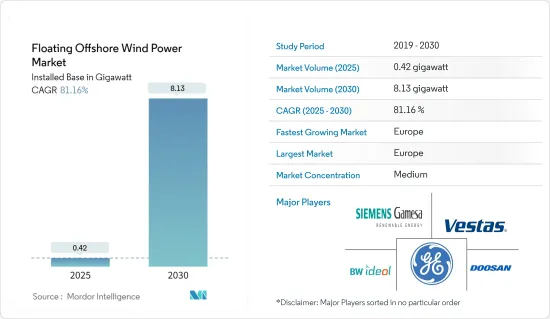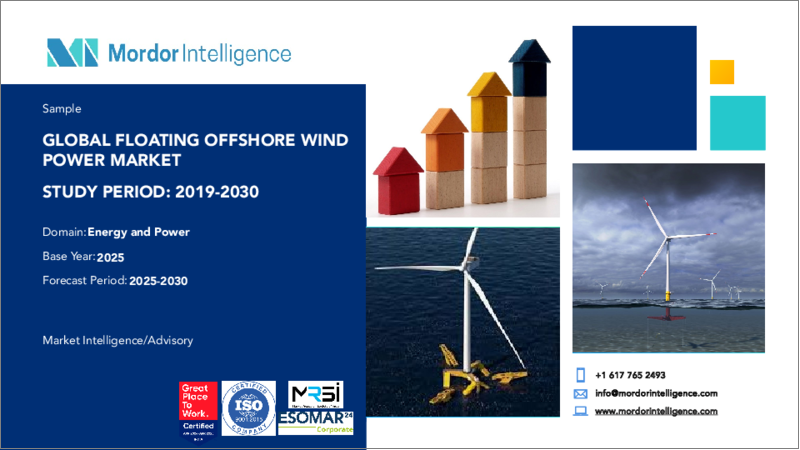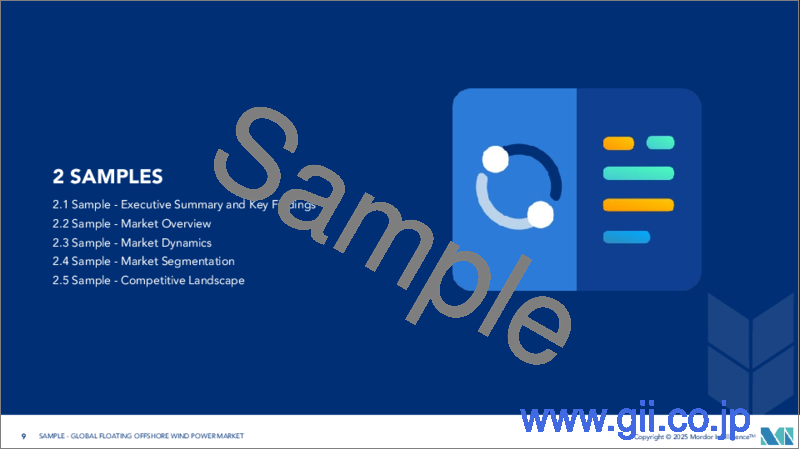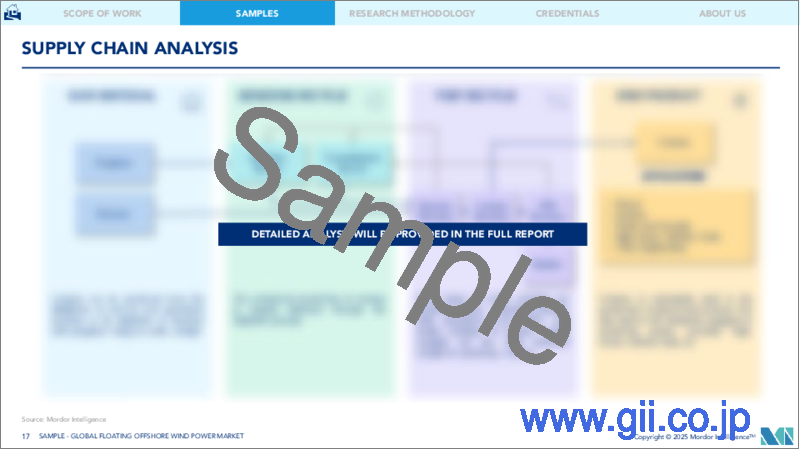|
|
市場調査レポート
商品コード
1687431
浮体式洋上風力発電-市場シェア分析、産業動向・統計、成長予測(2025年~2030年)Floating Offshore Wind Power - Market Share Analysis, Industry Trends & Statistics, Growth Forecasts (2025 - 2030) |
||||||
カスタマイズ可能
適宜更新あり
|
|||||||
価格
| 浮体式洋上風力発電-市場シェア分析、産業動向・統計、成長予測(2025年~2030年) |
|
出版日: 2025年03月18日
発行: Mordor Intelligence
ページ情報: 英文 160 Pages
納期: 2~3営業日
|
- 全表示
- 概要
- 目次
概要
浮体式洋上風力発電の設置ベース市場規模は、2025年の0.42ギガワットから2030年には8.13ギガワットに拡大し、予測期間(2025年~2030年)のCAGRは81.16%になると予測されます。

主なハイライト
- 中期的には、洋上再生可能風力エネルギープロジェクトへの投資の増加と、先進的で容易に入手可能な洋上風力タービン技術が、予測期間中の浮体式洋上風力市場の主要促進要因になると予想されます。
- 一方で、代替再生可能エネルギー市場との厳しい競合が、予測期間中の浮体式洋上風力発電市場の抑制要因となります。
- とはいえ、浮体式洋上風力発電は、浮体式構造物に有利な未開拓の深海の開発で人気が高まっており、市場企業に十分な機会を提供しています。
- 欧州は、予測期間中、浮体式洋上風力発電市場を独占すると予想されます。同地域では、浮体式洋上風力発電プロジェクトが進行中であり、今後予定されているためです。
浮体式洋上風力発電市場の動向
過渡期水深(水深30m~60m)セグメントが成長する見込み
- 浮体式洋上風力発電(FOWT)技術は、水深が深く、プロジェクトの経済性が高いことから、過渡的水深(水深30~60m)で開発が進んでいます。バージ型は、浅水域で最も商業的に実行可能な浮体式風力タービン設計です。このモデルは30メートル(m)以上の活動に適しており、あらゆる浮体式基礎の中で喫水が最も浅いです。
- バージ式浮体式風力タービンは設置面積が正方形であるが、他の設計では波による荷重がもたらす応力を軽減するためにムーンプールが組み込まれています。GWECによると、典型的な6メガワットの浮体式バージ風力タービンの重量は2,000トンから8,000トンです。しかし、Damping Pool Barge Floating Substructure Technologyを持つBW Ideol社は、MW規模のバージ型FOWTを展開している唯一の企業です。
- 水深が浅いため、FOWT技術は固定ベース技術に比べ、ビジネスの観点からは実用的ではないです。予測期間中、バージ技術はFOWT市場のごく一部を占めると予想されます。米国環境保護庁によると、2021年時点で世界で稼働しているバージ式FOWT容量はわずか5MWです。はしけによるFOWT容量は約1,932MWで、これは全世界で発表された将来のプロジェクトのための洋上風力下部構造技術全体の2.1%にあたる。
- ほとんどの企業は、より深水域で使用できるFOWT設計を市場に投入しようとしています。しかし、半潜水式技術の中には、過渡的な水深でも使用できるものもあります。半潜水型設計をベースにしたいくつかの商業的FOWTモデルにより、過渡的な水深でも機能することができます。これらのモデルのいくつかは、当初は実験プロジェクトで使用されたが、他のモデルは営利目的のベンチャーで使用するために改良されました。
- 米国エネルギー省の風力エネルギー技術局(WETO)は2024年4月24日、浮体式洋上風力プラットホームの研究開発を含む洋上風力技術の地域的・国家的研究開発のための4,800万米ドルの資金提供の機会を含む意向通知を発行する意向であることを発表しました。これは、同市場の将来的な成長の可能性を約束するものです。
- 国際再生可能エネルギー機関(IEA)のRE Capacity 2024によると、2023~24年度の世界の洋上風力発電設備容量は17.26%増加し、2022年の設備容量61,967MWに2023年には10,696MWが追加されました。このような開発は、市場開拓者にとって近い将来有望な展望を示しています。
- 過渡期にあるFOWTプロジェクトの大半は欧州、特に英国、スカンジナビア、フランスで大規模プロジェクトが計画段階にあると思われます。予測期間中、このセグメントにおける配備の大半はこれらの地域で行われると思われます。
- 従って、過渡的水深(水深30m~60m)セグメントは予測期間中に大きく成長すると予想されます。
欧州が市場を独占する見通し
- 欧州は、洋上風力発電設備において世界最大のシェアを占めています。欧州連合によると、欧州は世界の洋上風力発電設備の4分の1を占めています。同国(主に北海諸国)は、洋上風力発電市場の舵取り役となりそうです。
- 洋上風力発電設備の約85%は、世界全体で欧州海域に設置されています。特に北海地域の各国政府は、領海内に洋上風力発電所を設置する野心的な目標を掲げています。
- EolMedプロジェクトは、地中海におけるフランス初の浮体式パイロット・ウィンドファームです。2022年5月、トタルエナジー社はこのプロジェクトの建設開始を発表し、2024年までの稼働を目指しています。このプロジェクトは、水深62メートルの海底に固定された3基の10MW浮体式タービンで構成されています。タービンは、減衰プールを備えたバージ設計を採用します。
- 国際再生可能エネルギー機関(International Renewable Energy Agency)のRE Capacity 2024によると、2023-24年度の欧州の洋上風力発電設備容量は9.58%増加し、2022年の設備容量29,539MWに2023年には2,830MWが追加されました。こうした開発は、市場関係者にとって近い将来有望な展望を示しています。
- 2023年8月、世界最大の浮体式ウィンドファームであるハイウィンド・タンペン・プロジェクトが、ノルウェー沖約140kmの水深270~310mで稼働を開始しました。ハイウィンド・タンペンは11基の浮体式風力タービンを使用し、システム容量は88MW。洋上の石油・ガスプラットフォームでの電力供給に貢献しています。
- 2024年5月、再生可能エネルギー分野で著名なInvenergy社は、ア・コルーニャで552MWの浮体式洋上風力発電プロジェクトの計画を発表しました。O Boi」と名付けられたこのプロジェクトは、風力発電のポテンシャルが大きいと中央政府が認めた地帯の沖合45.7~60kmに設置されます。O Boi'プロジェクトが稼動すれば、ガリシア州の電力需要の約15%をまかない、60万戸以上の住宅に電力を供給することができます。
- 予測期間中、こうした動向により、欧州は浮体式洋上ウィンドファームに関わる重要な企業となるはずです。
浮体式洋上風力発電産業の概要
浮体式洋上風力発電市場は細分化されています。同市場の主要企業には、GE社、Doosan Energy社、Siemens Gamesa Renewable Energy社、BW Ideaol SA社、Vestas Wind Systems AS社などがあります。
その他の特典:
- エクセル形式の市場予測(ME)シート
- 3ヶ月間のアナリスト・サポート
目次
第1章 イントロダクション
- 調査範囲
- 市場の定義
- 調査の前提
第2章 エグゼクティブサマリー
第3章 調査手法
第4章 市場概要
- イントロダクション
- 浮体式洋上風力発電の2029年までの累積設置容量予測
- 主要プロジェクト情報
- 主な既存プロジェクト
- 今後のプロジェクト
- 最近の動向と開発
- 政府の規制と政策
- 市場力学
- 促進要因
- 洋上風力エネルギープロジェクトへの投資増加
- 先進的で容易に入手可能な洋上風力タービン技術
- 抑制要因
- 代替再生可能エネルギー市場との厳しい競合
- 促進要因
- サプライチェーン分析
- ポーターのファイブフォース分析
- 供給企業の交渉力
- 消費者の交渉力
- 新規参入業者の脅威
- 代替品の脅威
- 競争企業間の敵対関係の強さ
- 投資分析
第5章 市場セグメンテーション
- 水深別(定性分析のみ)
- 浅水域(水深30m未満)
- 過渡的水深(水深30m~60m)
- 深水域(水深60m以上)
- 地域別
- 北米
- 米国
- カナダ
- その他の北米
- 欧州
- 英国
- ドイツ
- フランス
- イタリア
- スペイン
- 北欧諸国
- ロシア
- その他の欧州
- アジア太平洋
- 中国
- インド
- 日本
- 韓国
- マレーシア
- ベトナム
- タイ
- インドネシア
- その他のアジア太平洋
- 南米
- ブラジル
- アルゼンチン
- コロンビア
- その他の南米
- 中東・アフリカ
- サウジアラビア
- アラブ首長国連邦
- エジプト
- 南アフリカ
- ナイジェリア
- その他の中東・アフリカ
- 北米
第6章 競争情勢
- 合併、買収、提携、合弁事業
- Strategies and SWOT Adopted by Leading Players
- 企業プロファイル
- Vestas Wind Systems AS
- General Electric Company
- Siemens Gamesa Renewable Energy SA
- BW Ideol AS
- Equinor ASA
- Marubeni Corporation
- RWE AG
- Doosan Enerbility Co. Ltd
- 市場ランキング分析
- List of Other Prominent Companies
第7章 市場機会と今後の動向
- 未開拓の沖合深海における浮体式洋上風力発電プロジェクトの開発
目次
Product Code: 62712
The Floating Offshore Wind Power Market size in terms of installed base is expected to grow from 0.42 gigawatt in 2025 to 8.13 gigawatt by 2030, at a CAGR of 81.16% during the forecast period (2025-2030).

Key Highlights
- Over the medium term, rising investments in offshore renewable wind energy projects, coupled with advanced and readily accessible offshore wind turbine technologies, are expected to be major drivers of the floating offshore wind market during the forecast period.
- On the other hand, tough competition from alternate renewable energy markets will restrain the floating offshore wind market during the forecast period.
- Nevertheless, floating offshore wind energy is becoming more popular in developing untapped deep-water prospects favorable for floating structures, providing ample opportunities for the market players.
- Europe is expected to dominate the floating offshore wind market during the forecast period. Owing to ongoing and upcoming floating offshore wind energy projects in the region.
Floating Offshore Wind Power Market Trends
The Transitional Water (30 m to 60 m depth) Segment is Expected to Grow
- Due to the greater water depth and favorable project economics, floating offshore wind turbine (FOWT) technology is more developed in transitional water depths (30-60 meters). The barge variant is the most commercially viable floating wind turbine design at shallow depths. This model is appropriate for activities higher than 30 meters (m) and has the shallowest draft of any floating foundation.
- Barge-style floating wind turbines have a square footprint, while other designs incorporate a moonpool to lessen stresses brought on by wave-induced loads. According to GWEC, a typical 6-megawatt floating barge wind turbine weighs between 2,000 and 8,000 tons. However, BW Ideol, with its Damping Pool Barge Floating Substructure Technology, is the only company that has deployed barge-type FOWT at the MW scale.
- Since the water depth is shallower, FOWT technology is less practical from a business point of view than fixed-base technology. During the forecast period, barge technology is expected to make up a small part of the FOWT market. According to the US EPA, only 5 MW of barge FOWT capacity operated globally as of 2021. Around 1,932 MW of FOWT capacity on barges, or 2.1% of all announced offshore wind substructure technologies for future projects worldwide, was announced.
- Most companies attempt to market FOWT designs that can be used in deeper waters. However, some semi-submersible technologies can also be used at transitional water depths. They can function at transitional depths due to several commercial FOWT models that are built on the semi-submersible design. A few of these models were initially used in experimental projects, while others were modified for use in ventures for profit.
- The US Department of Energy's Wind Energy Technologies Office (WETO) announced on April 24, 2024, that it intended to issue a Notice of Intent involving a USD 48 million funding opportunity for regional and national research and development of offshore wind technologies, including floating offshore wind platform research and development. This promises future growth potential for the market.
- According to the International Renewable Energy Agency RE Capacity 2024, the global installed offshore wind energy capacity increased by 17.26% in FY 2023-24, adding 10,696 MW in 2023 to the earlier installed capacity of 61,967 MW in 2022. Such developments show promising outlooks for the market players in the near future.
- Most of the FOWT projects in transitional depths are likely to be in Europe, especially in the United Kingdom, Scandinavia, and France, where large projects are in the planning stages. During the forecast period, most of the deployments in this segment are likely to happen in these regions.
- Thus, the transitional water (30 m to 60 m depth) segment is expected to grow significantly during the forecast period.
Europe is Expected to Dominate the Market
- Europe holds the largest share of offshore wind energy installations globally. According to the European Union, Europe represents a quarter of global offshore wind installations. The country (primarily North Sea countries) is likely to be at the helm of the offshore wind market.
- Around 85% of offshore wind installations are globally in European waters. Governments, particularly in the North Sea area, have set ambitious targets for installing offshore wind farms in their territorial waters.
- The EolMed project is France's first floating pilot wind farm in the Mediterranean Sea. In May 2022, TotalEnergies announced the start of the project's construction, which is expected to be operational by 2024. The project consists of three 10 MW floating turbines on the bathymetry of the 62-meter depth and anchored to the seabed. The turbines will use a barge design with a damping pool.
- According to the International Renewable Energy Agency RE Capacity 2024, the installed offshore wind energy capacity in Europe increased by 9.58% in FY 2023-24, adding 2,830 MW in 2023 to the earlier installed capacity of 29,539 MW in 2022. Such developments show promising outlooks for the market players in the near future.
- In August 2023, the world's largest floating wind farm, the Hywind Tampen Project, started operating around 140 kilometers off the coast of Norway in depths ranging from 270 to 310 meters. Hywind Tampen uses 11 floating wind turbines and has a system capacity of 88 MW. It helps power operations at offshore oil and gas platforms.
- In May 2024, Invenergy, a prominent player in the renewable energy sector, unveiled its plans for a 552 MW floating offshore wind project in A Coruna. Dubbed 'O Boi', the project will be situated 45.7 to 60 kilometers offshore, in a zone recognized by the central government for its significant wind potential. Once operational, the 'O Boi' project aims to meet approximately 15% of Galicia's electricity demand, sufficient to energize over 600,000 residences.
- During the forecast period, these trends should make Europe a significant players involved in floating offshore wind farms.
Floating Offshore Wind Power Industry Overview
The floating offshore wind power market is semi-fragmented. Some major players in the market include General Electric Company, Doosan Energy, Siemens Gamesa Renewable Energy, BW Ideaol SA, and Vestas Wind Systems AS.
Additional Benefits:
- The market estimate (ME) sheet in Excel format
- 3 months of analyst support
TABLE OF CONTENTS
1 INTRODUCTION
- 1.1 Scope of the Study
- 1.2 Market Definition
- 1.3 Study Assumptions
2 EXECUTIVE SUMMARY
3 RESEARCH METHODOLOGY
4 MARKET OVERVIEW
- 4.1 Introduction
- 4.2 Floating Offshore Wind Power Cumulative Installed Capacity Forecast, till 2029
- 4.3 Key Projects Information
- 4.3.1 Major Existing Projects
- 4.3.2 Upcoming Projects
- 4.4 Recent Trends and Developments
- 4.5 Government Policies and Regulations
- 4.6 Market Dynamics
- 4.6.1 Drivers
- 4.6.1.1 Rising Investments in Offshore Wind Energy Projects
- 4.6.1.2 Advanced and Readily Accessible Offshore Wind Turbine Technologies
- 4.6.2 Restraint
- 4.6.2.1 Tough Competition from Alternate Renewable Energy Markets
- 4.6.1 Drivers
- 4.7 Supply Chain Analysis
- 4.8 Porter's Five Forces Analysis
- 4.8.1 Bargaining Power of Suppliers
- 4.8.2 Bargaining Power of Consumers
- 4.8.3 Threat of New Entrants
- 4.8.4 Threat of Substitute Products and Services
- 4.8.5 Intensity of Competitive Rivalry
- 4.9 Investment Analysis
5 MARKET SEGMENTATION
- 5.1 By Water Depth (Qualitative Analysis Only)
- 5.1.1 Shallow Water (less than 30 m depth)
- 5.1.2 Transitional Water (30 m to 60 m depth)
- 5.1.3 Deep Water (higher than 60 m depth)
- 5.2 By Geography
- 5.2.1 North America
- 5.2.1.1 United States
- 5.2.1.2 Canada
- 5.2.1.3 Rest of North America
- 5.2.2 Europe
- 5.2.2.1 United Kingdom
- 5.2.2.2 Germany
- 5.2.2.3 France
- 5.2.2.4 Italy
- 5.2.2.5 Spain
- 5.2.2.6 Nordic Countries
- 5.2.2.7 Russia
- 5.2.2.8 Rest of Europe
- 5.2.3 Asia-Pacific
- 5.2.3.1 China
- 5.2.3.2 India
- 5.2.3.3 Japan
- 5.2.3.4 South Korea
- 5.2.3.5 Malaysia
- 5.2.3.6 Vietnam
- 5.2.3.7 Thailand
- 5.2.3.8 Indonesia
- 5.2.3.9 Rest of Asia-Pacific
- 5.2.4 South America
- 5.2.4.1 Brazil
- 5.2.4.2 Argentina
- 5.2.4.3 Colombia
- 5.2.4.4 Rest of South America
- 5.2.5 Middle East and Africa
- 5.2.5.1 Saudi Arabia
- 5.2.5.2 United Arab Emirates
- 5.2.5.3 Egypt
- 5.2.5.4 South Africa
- 5.2.5.5 Nigeria
- 5.2.5.6 Rest of the Middle East and Africa
- 5.2.1 North America
6 COMPETITIVE LANDSCAPE
- 6.1 Mergers, Acquisitions, Collaboration and Joint Ventures
- 6.2 Strategies and SWOT Adopted by Leading Players
- 6.3 Company Profiles
- 6.3.1 Vestas Wind Systems AS
- 6.3.2 General Electric Company
- 6.3.3 Siemens Gamesa Renewable Energy SA
- 6.3.4 BW Ideol AS
- 6.3.5 Equinor ASA
- 6.3.6 Marubeni Corporation
- 6.3.7 RWE AG
- 6.3.8 Doosan Enerbility Co. Ltd
- 6.4 Market Ranking Analysis
- 6.5 List of Other Prominent Companies
7 MARKET OPPORTUNITIES AND FUTURE TRENDS
- 7.1 Developing Floating Offshore Wind Projects in Untapped Offshore Deep-water Prospects
お電話でのお問い合わせ
044-952-0102
( 土日・祝日を除く )






